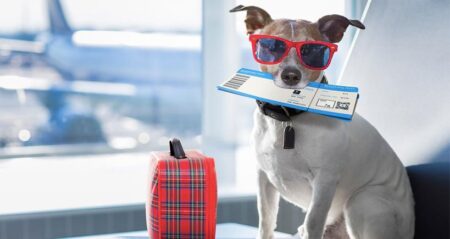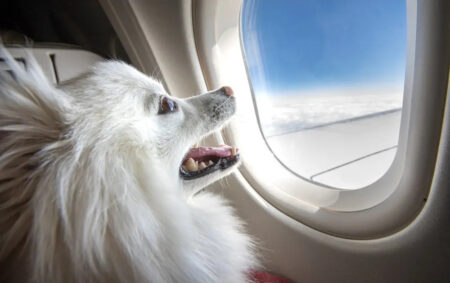Many pet owners love traveling with their furry companions, and taking them on a flight is no exception. While most airlines allow pets to fly in the cabin or the cargo hold, many pet owners wonder if they can purchase a separate seat for their dog on an airplane.
The short answer is no, most airlines do not allow passengers to purchase a seat specifically for their pet. However, there are a few things you can do to ensure your pet’s comfort and safety during a flight.
Can I Buy a Seat for My Dog on an Airplane?
No, you cannot buy a seat for your dog on an airplane. Pets are not allowed in the cabin of the airplane, except for service animals. Some airlines do allow small pets to travel in the cabin, but they must be in an approved carrier and usually count as your carry-on item. Most airlines require pets to be transported in the cargo hold area, where they will be checked in as checked luggage. This is for the safety and comfort of your pet, as well as the safety and comfort of other passengers. It is important to check with your airline for their specific pet policies and guidelines.
SEE ALSO: Dog Daycare Near Me: Best Doggy Day Care Services
Are Flights Traumatic for Dogs?
Flights can be traumatic for dogs, especially if they are not used to traveling or are prone to anxiety. The loud noises, unfamiliar environment, and separation from their owners can cause a lot of stress for dogs. Additionally, some dogs may experience motion sickness, discomfort, or even fear during takeoff and landing. Proper preparation and accommodations can help minimize the potential trauma for dogs during flights.
How Much Does Flying with Dogs Cost?
The cost of flying with dogs can vary depending on the airline, the size and weight of the dog, and the specific flight details. Generally, flying with a dog can cost anywhere from $75-$250, with some airlines charging additional fees for larger dogs or international flights. Some airlines may also require a health certificate or other documentation, which may have additional fees. It is best to check with the airline directly for their specific fees and requirements for flying with dogs.
What Dogs Are Allowed to Travel in The Cabin of An Airplane?
Pets Allowed to Travel in The Cabin:
- Service Dogs: Service dogs can travel in the cabin with their handlers on all airlines. These dogs are trained to assist individuals with physical or mental disabilities and are recognized as essential medical aid. Service dogs can travel free of charge and do not require a carrier.
- Emotional Support Dogs: Like service dogs, emotional support dogs can travel in the cabin with their owners on most airlines. These dogs provide comfort and support to individuals with emotional or psychological disabilities. Emotional support dogs require documentation from a mental health professional and may require a small fee.
- Small Dogs: Many airlines allow small dogs to travel in the cabin if they can fit comfortably in an airline-approved carrier stowed under the seat in front of the owner. Each airline has specific size and weight restrictions for pets in the cabin, so it is important to check with the airline before booking.
- Therapy Dogs: Therapy dogs are different from service and emotional support dogs as they are trained to provide comfort and affection to people in public places. Some airlines may allow therapy dogs to travel in the cabin with their handlers, but it is important to check with the airline beforehand.
- Puppies and Kittens: Some airlines allow puppies and kittens to travel in the cabin as long as they meet the size and weight restrictions and are at least 8-10 weeks old. However, there may be additional requirements and fees for traveling with a young pet, so it is important to check with the airline before booking.
Which Airline Will Let You Buy a Seat for Your Dog?
Several airlines allow passengers to purchase seats for their dogs, including:
- American Airlines: This airline offers a program called “First Class Pet Cabin Service” where certain breeds of dogs can travel in the cabin with their owners for an additional fee.
- Delta Air Lines: Delta allows small dogs, cats, and household birds to travel in the cabin with their owners for an additional fee.
- United Airlines: United offers a program called “Petsafe” where pets can travel either in the cabin or the cargo hold for an additional fee.
- JetBlue: JetBlue allows small dogs and cats to travel in the cabin with their owners for an additional fee.
- Southwest Airlines: This airline allows small dogs and cats to travel in the cabin with their owners for an additional fee.
- Alaska Airlines: Alaska Airlines allows dogs and cats to travel in the cabin with their owners for an additional fee.
Each airline has its own specific rules and regulations regarding traveling with pets, so it is important to check with the airline before booking a seat for your dog. Additionally, it is important to note that not all breeds and sizes of dogs are allowed to travel in the cabin, and certain restrictions may apply. It is recommended to book well in advance.
Documents Required for Moving or Flying Internationally with Pets
- Valid Pet Passport: Most countries require a pet passport for international travel, which serves as a pet’s official identification and contains important documentation such as vaccinations and health certificates.
- Current Vaccinations: Most airlines and countries require pets to be up-to-date on vaccinations, including rabies before they are allowed to fly or enter the country.
- Health Certificate: A signed health certificate from a licensed veterinarian is usually required for traveling internationally with a pet. This certificate states that your pet is healthy and fit for travel.
- Microchip: Some countries require pets to have a microchip for identification purposes. Even if it is not a mandatory requirement, it is highly recommended to have your pet microchipped before traveling internationally in case they get lost.
- Import/Export Permits: Certain countries have strict regulations for importing or exporting pets, and a permit may be required. Make sure to check the requirements of your destination country and obtain any necessary permits in advance.
- Pet Travel Crate: Airlines have specific requirements for pet travel crates, including size and material. Make sure to purchase a crate that is approved by the airline and provides enough space for your pet to stand up, turn around, and lie down comfortably.
- Letter of Authorization: If someone else will be accompanying your pet on the flight, a notarized letter of authorization from you must be provided. This is also known as a “letter of consent” or “letter of attorney.”
How Do I Add My Dog to My Plane Ticket?
- Contact the airline: The first step to adding your dog to your ticket is to contact the airline you will be flying with. Most airlines have specific policies and procedures for traveling with pets, so it is important to familiarize yourself with their requirements.
- Check for availability: Before booking your ticket, check with the airline to make sure that there is space available for your dog on the flight. Some airlines have limits on the number of pets allowed per flight, so it is best to check in advance.
- Check for breed and size restrictions: Many airlines have restrictions on the breed and size of dogs allowed in the cabin. Make sure your dog meets these requirements before booking your ticket.
- Book your ticket: Once you have confirmed availability and your dog meets the airline’s requirements, go ahead and book your ticket. You may be able to add your dog to the ticket at the time of booking or you may need to call the airline to add them later.
- Provide necessary documentation: Most airlines require proof of your dog’s health and vaccination records before they can travel. Make sure to have these documents ready to present at check-in.
- Pay the pet fee: Airlines typically charge a pet fee for traveling with your dog. This fee can vary depending on the airline and the size of your dog. Be prepared to pay this fee when you check-in for your flight.
- Purchase a carrier: If your dog will be traveling in the cabin with you, you will need to purchase an airline-approved carrier for them to travel in. Make sure the carrier meets the airline’s size and weight restrictions.
- Confirm with the airline: It is always a good idea to call the airline a few days before your flight to confirm that your dog has been added to your ticket and to reconfirm any necessary details.
- Prepare your dog for the flight: Make sure your dog has had a bathroom break and has been exercised before the flight. You may also want to limit their food and water intake a couple of hours before the flight to avoid any accidents.
- Check-in with your dog: When you check in for your flight, make sure to let the airline staff know that you have a dog traveling with you. They may need to inspect your dog’s carrier and documents before allowing them on the plane.
What Are The Rules And Regulations for Flying With Dogs in Cabin?
- Size Limitations: Most airlines have specific size limitations for dogs flying in the cabin, typically around 20 pounds. Larger dogs may have to travel in the cargo hold.
- Age Restrictions: Puppies under 8 weeks old are not allowed to fly in the cabin. Some airlines may also have restrictions on the age of the dog, typically around 6-8 months.
- Health Requirements: Most airlines require a current health certificate from a veterinarian stating that the dog is in good health and up to date on vaccinations. Some airlines may also require proof of flea and tick treatment.
- Carrier Requirements: The dog must be in an airline-approved carrier that fits comfortably under the seat in front of you. The carrier should be well-ventilated, leak-proof, and have enough space for the dog to stand up, turn around, and lie down comfortably.
- Reservation: It is important to reserve a spot for your dog on the flight in advance as most airlines have a limited number of spots available for dogs in the cabin.
- Check-in: You will need to check in your dog at the airport, even if you have an electronic boarding pass. Some airlines may require an additional fee for cabin pets.
- Leash and Harness: Your dog should be properly leashed and harnessed while in the airport and during the flight.
- Behavior: Your dog should be well-behaved and not disruptive during the flight. Aggressive or excessively noisy dogs may not be allowed to fly in the cabin.
- Food and Water: Some airlines may require that you do not feed your dog 4-6 hours before the flight to prevent accidents. However, you should provide water and a small amount of food for longer flights.
- Potty Breaks: It is important to take your dog for a potty break before boarding the flight. Some airlines may allow you to take your dog to designated pet relief areas during layovers.
It is important to also check with your specific airline for any additional rules and regulations they may have in place for flying with dogs in the cabin. It is always best to be prepared and have all the necessary documentation and equipment to ensure a smooth and comfortable flight for both you and your furry companion.
The Pros and Cons of Flying with a Dog in the Cabin
As a dog owner, you may have considered taking your furry friend on a flight with you in the cabin. While this may seem like a great idea, there are both pros and cons to flying with a dog in the cabin. It’s important to consider these before making a decision, as it ultimately comes down to the safety and comfort of your pet.
Pros:
- Your Dog Stays With You: One of the biggest advantages of flying with a dog in the cabin is that your pet gets to stay with you throughout the flight. This can be comforting for both you and your dog, as they will not be separated from you for an extended period.
- Less Stressful for Your Dog: Traveling can be a stressful experience for dogs, especially if they are traveling in the cargo hold. By flying in the cabin, your dog is in a familiar and more controlled environment, which may help to reduce their stress levels.
- Easier to Monitor Your Dog: When your dog is in the cabin with you, you can easily keep an eye on them and monitor their needs. This includes their bathroom breaks, food and water intake, and any signs of distress or discomfort.
- More Comfortable for Your Dog: The cabin of a plane is pressurized and temperature controlled, making it a more comfortable environment for your dog. They will also have more space to move around and stretch their legs compared to being confined in a crate in the cargo hold.
Cons:
- Limited Availability and Restrictions: Not all airlines allow pets to travel in the cabin and those that do often have restrictions on the size and breed of dogs that are allowed. This can make it more difficult to plan your trip with your dog and may limit your options for airlines and flights.
- Additional Fees: Flying with a dog in the cabin usually incurs an additional fee from the airline. This can range from $50 to over $200, depending on the airline and size of your dog. You may also have to pay for additional pet supplies such as a travel carrier or food and water bowls.
- Potential Discomfort During Takeoff and Landing: During takeoff and landing, the airplane experiences changes in air pressure, which can be uncomfortable for your dog’s ears. Some dogs may also experience fear or anxiety during these times, which can be difficult to manage in a cramped cabin space.
- More Responsibility and Potential Stress for You: Traveling with a dog in the cabin also means that you are responsible for your pet’s behavior and well-being throughout the flight. This can be stressful and require more planning and preparation on your part.
How to Prepare Your Dog for a Flight
- Schedule a veterinary check-up: Before planning your dog’s flight, it’s important to make sure they are up-to-date on all their vaccinations and in good overall health. Schedule a visit with your veterinarian to get a health certificate and any necessary vaccinations or medications for the flight.
- Get the right carrier: Make sure to get a carrier that is approved by the airline you are flying with. The carrier should be large enough for your dog to stand up and turn around, with plenty of ventilation. Familiarize your dog with the carrier by keeping it out in your house, placing treats and toys inside, and taking short trips with your dog in the carrier.
- Take practice trips: If your dog is not used to traveling, it may be helpful to take short car trips or trips to the airport in their carrier to help them get used to the sensation of being in a confined space. This will also allow you to see how your dog reacts to the carrier and help you make any necessary adjustments.
- Pack essentials: Make sure to pack all the necessary items for your dog’s flight, including food, water, treats, a collar with identification, and any necessary medications. Also, bring a copy of your dog’s health certificate and vaccination records in case they are needed.
- Monitor feeding and watering: It’s important to monitor your dog’s food and water intake before the flight. Do not feed your dog a big meal before the flight to avoid any digestive issues. Offer small amounts of water throughout the day leading up to the flight, but stop giving water 2-3 hours before the flight to avoid accidents.
- Exercise your dog: Before the flight, take your dog for a long walk or engage in some other form of physical activity to help them release excess energy and relax before the flight.
- Introduce your dog to airport noises: The airport can be a loud and overwhelming place for dogs. To help your dog adjust, expose them to similar sounds in the days leading up to the flight. You can also request a pet relief area at the airport so your dog can relieve themselves before the flight.
- Arrive early: Arrive at the airport early to give yourself plenty of time to check in and go through security. This will help reduce any stress or anxiety for both you and your dog.
- Stay calm: Dogs are very perceptive and can pick up on their owner’s emotions. Make sure to stay calm and relaxed to help your dog feel more at ease during the flight.
SEE ALSO: Golden Retriever: Everything You Need To Know
FAQs
Q. Do any airlines allow you to buy your dog a seat?
A. Some airlines do allow you to purchase a seat for your dog to travel with you in the cabin. JetBlue and Semiprivate Airlines all have policies that allow for this. However, the dog must be able to fit in a small carrier that can fit under the seat in front of you, and there may be weight and breed restrictions.
Q. Can I buy a seat for my dog on an international flight?
A. Many airlines allow you to buy a seat for your dog on an international flight, but there are a few things to keep in mind. First, not all airlines allow this, so it’s important to check with the specific airline you’re flying with. Second, the cost of buying a seat for your dog can vary greatly, so you’ll need to factor that into your budget. Finally, there may be additional restrictions or paperwork required for international flights, so make sure you’re aware of what’s required before you book.
Q. Can a dog sit with you on a plane?
A. Some airlines do allow you to bring your dog on the plane with you and have them sit with you in the cabin.
Q. Can I buy a seat for my dog on Alaska Airlines?
A. Yes, you can buy a seat for your dog on Alaska Airlines! Alaska Airlines is one of the few airlines that allow you to purchase a ticket for your dog and have them fly in the cabin with you.
Q. Can I buy a seat for my dog on American Airlines?
A. Yes, American Airlines allows passengers to purchase a ticket for their dog and have them fly in the cabin with them.
Q. Can I buy a seat for my dog on Jetblue?
A. Yes, Jetblue does allow passengers to buy a seat for their dog and have them fly in the cabin with them.
Conclusion
While some airlines may allow you to buy a seat for your dog, it is ultimately up to the discretion of the airline and the policies in place. It is important to check with the specific airline before booking tickets to ensure that your dog will be allowed to sit in a seat. Additionally, if your dog does require a seat, it is important to follow any guidelines or regulations set by the airline to ensure a safe and comfortable flight for both you and your dog.


